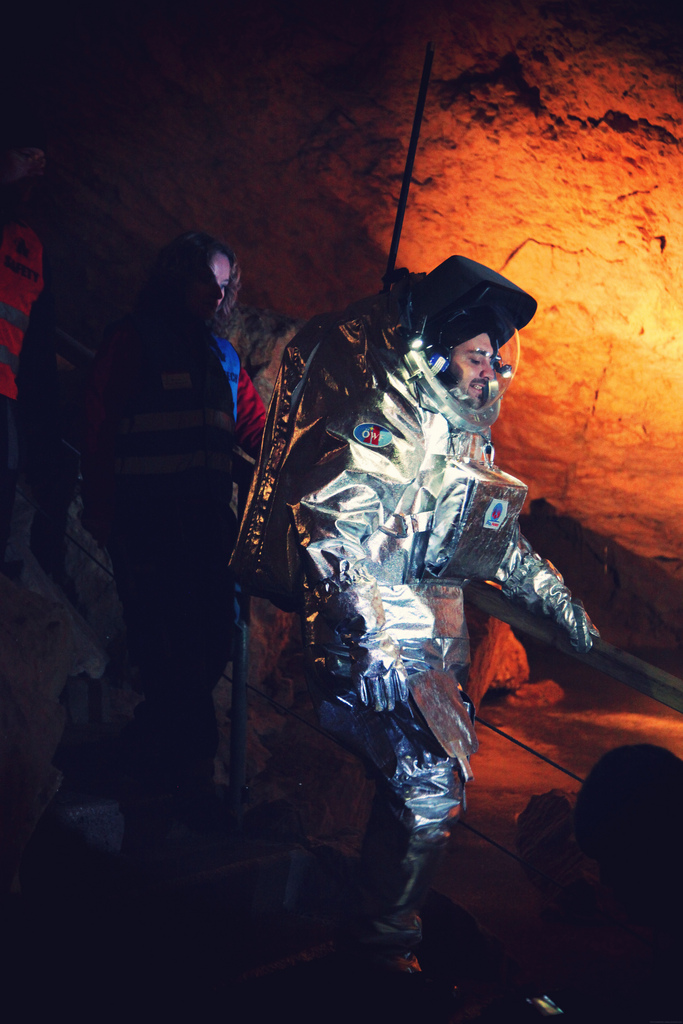Performing Mars
Performing Mars:  [Image: Image via Karst Worlds].
[Image: Image via Karst Worlds].
An ice cave in Austria was recently used as a test landscape for experimental spacesuits and instrumentation systems—including 3D cameras—that might someday be used by humans on Mars.
The Dachstein ice cave was chosen, Stuff explains, "because ice caves would be a natural refuge for any microbes on Mars seeking steady temperatures and protection from damaging cosmic rays."



 [Images: (top and bottom) Photos by Katja Zanella-Kux; middle photos via Karst Worlds].
[Images: (top and bottom) Photos by Katja Zanella-Kux; middle photos via Karst Worlds].
Many images available at the Dachstein Mars Simulation Liveblog—including this series of 25 images courtesy of the Austrian Space Forum—document the testing process, which ranged from the beautifully surreal, as a fully space-suited man rolls strange devices down slopes of ice inside the planet, to the nearly postmodern, as crowds of normally dressed tourist onlookers are revealed at the edges of the show cave, watching this odd performance unfold.
And all this is in addition to the "obstacle course" developed for wearers of the spacesuit—reverse-engineering terrain from a particular type of clothing, or landscape design as an outgrowth from fashion—in the parking lot and nearby paved spaces of a research center in Austria. "The course included four snow-mountain passages, almost 40 meters of rock climbing and more than 60 meters of slushy snow terrain amongst others"—including "drawing bright 'rocks' to make the simulation happen" accurately.
Walking amidst painted representations of geology, wearing a suit designed for the atmosphere of another planet, and temporarily moving below the surface of the earth to throw pieces of specialty equipment down ice slopes, attached to ropes, the team was able to, by means of props and in William L. Fox's words, "perform Mars on Earth."
(Spotted via Karst Worlds).

 [Image: Image via Karst Worlds].
[Image: Image via Karst Worlds].An ice cave in Austria was recently used as a test landscape for experimental spacesuits and instrumentation systems—including 3D cameras—that might someday be used by humans on Mars.
The Dachstein ice cave was chosen, Stuff explains, "because ice caves would be a natural refuge for any microbes on Mars seeking steady temperatures and protection from damaging cosmic rays."



 [Images: (top and bottom) Photos by Katja Zanella-Kux; middle photos via Karst Worlds].
[Images: (top and bottom) Photos by Katja Zanella-Kux; middle photos via Karst Worlds].Many images available at the Dachstein Mars Simulation Liveblog—including this series of 25 images courtesy of the Austrian Space Forum—document the testing process, which ranged from the beautifully surreal, as a fully space-suited man rolls strange devices down slopes of ice inside the planet, to the nearly postmodern, as crowds of normally dressed tourist onlookers are revealed at the edges of the show cave, watching this odd performance unfold.
And all this is in addition to the "obstacle course" developed for wearers of the spacesuit—reverse-engineering terrain from a particular type of clothing, or landscape design as an outgrowth from fashion—in the parking lot and nearby paved spaces of a research center in Austria. "The course included four snow-mountain passages, almost 40 meters of rock climbing and more than 60 meters of slushy snow terrain amongst others"—including "drawing bright 'rocks' to make the simulation happen" accurately.
Walking amidst painted representations of geology, wearing a suit designed for the atmosphere of another planet, and temporarily moving below the surface of the earth to throw pieces of specialty equipment down ice slopes, attached to ropes, the team was able to, by means of props and in William L. Fox's words, "perform Mars on Earth."
(Spotted via Karst Worlds).
Comments
Post a Comment